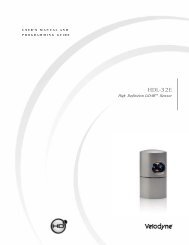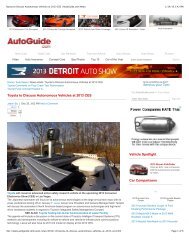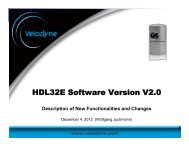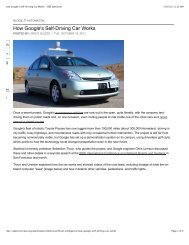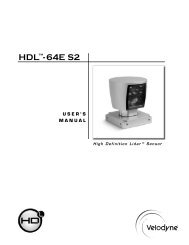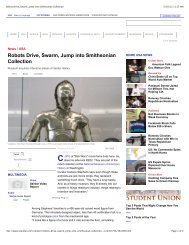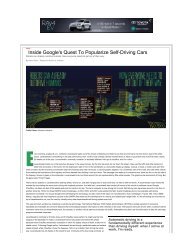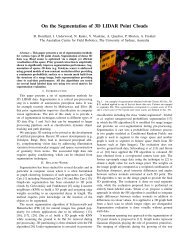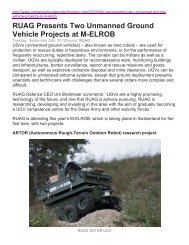HDLâ¢- 64E - Velodyne Lidar
HDLâ¢- 64E - Velodyne Lidar
HDLâ¢- 64E - Velodyne Lidar
You also want an ePaper? Increase the reach of your titles
YUMPU automatically turns print PDFs into web optimized ePapers that Google loves.
PART 5: DESCRIPTION OF THE PRODUCT<br />
5.1 Describe the product and its function. You may refer to brochures and manuals submitted<br />
with this report. Please include drawings or photographs adequate to document compliance of<br />
the product with the performance and labeling requirements.<br />
Is a product description attached to this report?<br />
( X )Yes<br />
( )No<br />
Please identify attachment: _____________________<br />
The product consists of 64-piece laser array that is mountable on top of a vehicle. The<br />
array revolves around an axis sending out laser beams to collect terrain data. This terrain<br />
data is used for obstacle detection.<br />
The product is comprised of 4 Laser Assemblies consisting of 16 Lasers each (totaling 64<br />
lasers). Two Laser Assemblies are located in the upper plane (which are referred to as<br />
Upper Left Head and Upper Right Head) and two Laser Assemblies located in a lower plane<br />
(referred to as Lower Left Head and Lower Right Head). The Lower Heads are oriented so<br />
that aimed at the ground near the product. The Upper Heads are oriented so that these<br />
laser pulses are substantially directed also towards the ground, but to a further distance<br />
than the Lower Heads.<br />
Initially, two lasers in each of the upper heads are pulsed (for example Lasers 1 and 2). The<br />
optical pulse duration is approximately 5 nanoseconds. Four microseconds later (250 kHz<br />
burst frequency), two other lasers (Lasers 3 and 4) in each of the upper head are pulsed.<br />
Four microseconds later, two other lasers (Lasers 5 and 6) are triggered. This process<br />
repeats until all 16 lasers have been pulsed. The overall period for this sequencing of the<br />
laser pulses is 32 microseconds. This process of sequentially pulsing the 16 lasers in each<br />
of the upper heads repeats two additional times (for a total of three cycles).<br />
After these three cycles in the upper head, a single sequencing cycle is conducted for the<br />
Lower Heads. At the completion of this cycle, the loop repeats (3 Upper Head Cycles then 1<br />
Lower Head cycle).<br />
While transmitting laser pulses, the product will rotate at a rate of approximately 600<br />
revolutions per minute (10 revolutions per second).<br />
5.2 Describe the external and internal laser radiation fields and paths. Beam path diagrams<br />
indicating protective housing, beam attenuators, viewports, scanners, targets, etc. would be<br />
helpful. Please identify external and internal laser power or energy levels where applicable.<br />
Are description and diagrams of the laser radiation fields and paths attached?<br />
( X )Yes<br />
( )No<br />
Please identify attachment: ___See Figure 3<br />
- 10 -




